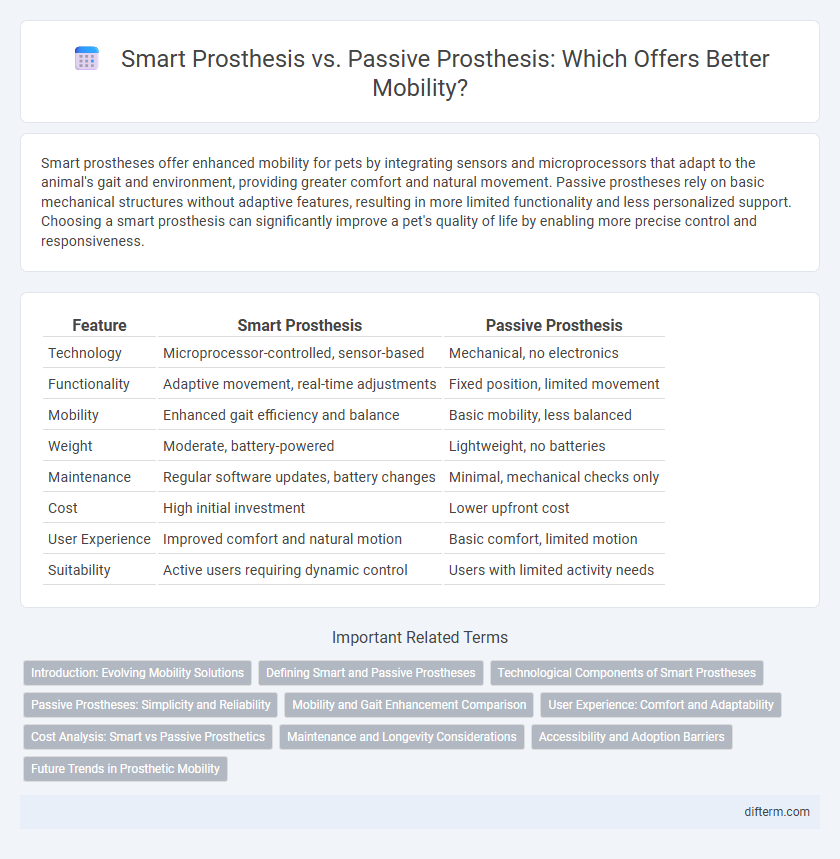Smart prostheses offer enhanced mobility for pets by integrating sensors and microprocessors that adapt to the animal's gait and environment, providing greater comfort and natural movement. Passive prostheses rely on basic mechanical structures without adaptive features, resulting in more limited functionality and less personalized support. Choosing a smart prosthesis can significantly improve a pet's quality of life by enabling more precise control and responsiveness.
Table of Comparison
| Feature | Smart Prosthesis | Passive Prosthesis |
|---|---|---|
| Technology | Microprocessor-controlled, sensor-based | Mechanical, no electronics |
| Functionality | Adaptive movement, real-time adjustments | Fixed position, limited movement |
| Mobility | Enhanced gait efficiency and balance | Basic mobility, less balanced |
| Weight | Moderate, battery-powered | Lightweight, no batteries |
| Maintenance | Regular software updates, battery changes | Minimal, mechanical checks only |
| Cost | High initial investment | Lower upfront cost |
| User Experience | Improved comfort and natural motion | Basic comfort, limited motion |
| Suitability | Active users requiring dynamic control | Users with limited activity needs |
Introduction: Evolving Mobility Solutions
Smart prostheses integrate advanced sensors and microprocessors to mimic natural limb movement, offering enhanced control and adaptability for users. Passive prostheses rely on basic mechanical structures, providing stability but limited functionality in dynamic environments. Innovations in smart prosthetics are revolutionizing mobility, improving user comfort and real-time responsiveness.
Defining Smart and Passive Prostheses
Smart prostheses incorporate advanced sensors, microprocessors, and actuators to adapt dynamically to the user's movements and environment, enhancing mobility and comfort. Passive prostheses lack electronics and mechanical components, relying solely on the user's physical effort for movement and support. The integration of intelligent technology in smart prostheses enables real-time adjustments, whereas passive prostheses provide static support without adaptive functionality.
Technological Components of Smart Prostheses
Smart prostheses incorporate advanced technological components such as microprocessors, sensors, and actuators that enable real-time adaptation to the user's movements and environmental conditions. These devices utilize electromyographic (EMG) sensors to detect muscle signals, allowing intuitive control and enhanced mobility compared to passive prostheses, which lack active feedback mechanisms. The integration of wireless connectivity and machine learning algorithms further optimizes functionality by personalizing gait patterns and improving responsiveness.
Passive Prostheses: Simplicity and Reliability
Passive prostheses offer unparalleled simplicity and reliability due to their mechanical design without electronic components, reducing maintenance needs and potential failures. Their lightweight structure and intuitive use make them ideal for individuals seeking durable mobility solutions without complex adjustments. These prostheses provide consistent, low-cost functionality, emphasizing comfort and straightforward operation over advanced technological features.
Mobility and Gait Enhancement Comparison
Smart prostheses incorporate advanced sensors and microprocessors to adapt in real-time to the user's movements, significantly improving mobility and gait symmetry compared to passive prostheses. Passive prostheses lack active components, resulting in limited adaptability and often causing increased energy expenditure and gait deviations. Studies show that users of smart prostheses experience smoother stride transitions, enhanced stability, and reduced risk of falls, which collectively contribute to superior functional mobility.
User Experience: Comfort and Adaptability
Smart prostheses offer enhanced user experience through adaptive sensors and microprocessor-controlled joints that provide greater comfort and natural movement compared to passive prostheses. Their ability to adjust in real-time to terrain changes and user activity reduces fatigue and skin irritation, promoting longer wear time and improved mobility. Passive prostheses lack these dynamic features, often resulting in limited adaptability and increased discomfort during extended use.
Cost Analysis: Smart vs Passive Prosthetics
Smart prostheses generally entail higher upfront costs due to advanced sensors, microprocessors, and adaptive technologies, often ranging from $20,000 to $100,000, whereas passive prostheses typically cost between $5,000 and $10,000 depending on material and customization. Maintenance and repair expenses for smart prostheses can be significant due to complex electronics requiring specialized service, contrasting with the relatively lower maintenance costs of passive prosthetics that involve simpler mechanical parts. Despite higher initial investment, smart prostheses may offer improved mobility and functionality that can reduce long-term healthcare costs associated with secondary complications.
Maintenance and Longevity Considerations
Smart prostheses require regular software updates and sensor calibrations to maintain optimal performance, while passive prostheses mainly demand routine mechanical inspections and occasional part replacements. The advanced electronics in smart prostheses may reduce their overall lifespan due to battery degradation and component wear, whereas passive prostheses typically offer longer durability with minimal maintenance. Longevity considerations for smart prostheses must factor in technological obsolescence, whereas passive models benefit from simpler, more robust designs that extend their functional life.
Accessibility and Adoption Barriers
Smart prostheses offer advanced sensory feedback and adaptive control, significantly improving user mobility and comfort, yet their high cost and complex maintenance create substantial accessibility barriers for many patients. Passive prostheses remain more affordable and widely available but lack functional adaptability, limiting user experience and acceptance. Widespread adoption of smart prosthetics depends on reducing production costs, enhancing durability, and increasing healthcare system support to overcome economic and technological hurdles.
Future Trends in Prosthetic Mobility
Smart prostheses integrate advanced sensors and AI algorithms to adapt to user movements, offering enhanced mobility and personalized functionality compared to passive prostheses. Future trends emphasize the development of neural interfaces and lightweight materials to improve responsiveness and comfort. Innovations in battery technology and real-time data processing are set to revolutionize prosthetic mobility by enabling seamless interaction between limbs and the nervous system.
Smart prosthesis vs Passive prosthesis Infographic

 difterm.com
difterm.com